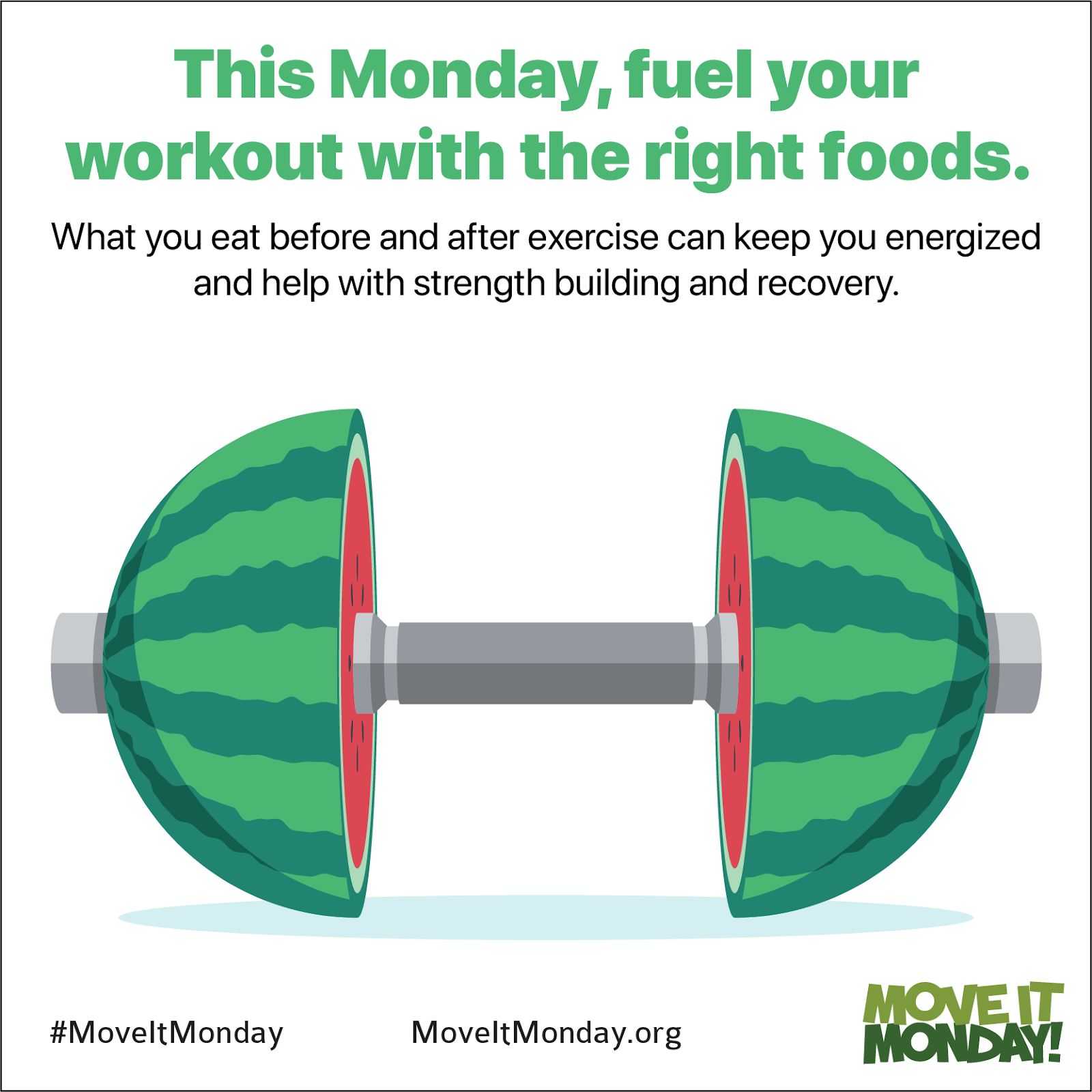Fuel Your Workout with Healthy Food Choices
What you eat before and after exercise is almost as important as the workout itself. Food is your fuel—it gives you the energy necessary to be active and focused, provides the nutrients required to build muscle and bone strength, and helps the body recover post-workout.
This Monday (while keeping your personal dietary restrictions at the forefront of your mind), plan some meals around your workouts.
What to Eat Before a Workout:
Carbohydrates help prepare the body for exercise, even if it’s something low-impact or low-intensity. Eat foods with the right nutrient balance to curb hunger and battle fatigue and avoid foods that might lead to an upset stomach.
Bananas: A great source of quick energy, bananas are 90% carbohydrates. Keep one in your backpack or bag, and you’ll never be without pre-workout fuel. Try adding them to this date and a banana smoothie for a pre-workout breakfast.
Oatmeal: Oatmeal is a breakfast staple full of fiber, making it a great food to eat before exercising. Because it’s a complex carbohydrate, oats release their energy gradually, making them an appropriate choice for longer-length workouts. Oats are also a good source of vitamin B, which helps convert carbohydrates into energy. For a quick recipe idea, make this overnight apple peanut butter oatmeal.
Whole Grain Bread: Another good source of fiber that’s easy on the stomach, whole grain bread provides sustained energy throughout the workout. If you’re looking for a complete pre-workout meal, try adding a spread of hummus or a sliced hard-boiled egg for extra protein.
What to Eat After a Workout:
After a workout, your body needs to heal and rebuild—but this is a good thing! Eating the proper nutrients after exercise can help your body speed up this process. The right combination of protein, carbohydrates, and fats can help increase muscle growth, decrease muscle protein breakdown, and enhance recovery. Foods high in protein allow the body to build new muscle tissue, while carbohydrate-rich foods are better for refueling after a run or another endurance exercise.
Beans: Beans are inexpensive, nutritious, and an excellent source of protein. Lean proteins, like beans, provide all the muscle-recovery benefits of protein without the saturated fat of red meats like beef or pork. Recreate the flavor of meatballs using beans with this yummy lentil, mushroom walnut “meatball.”
Quinoa: Although technically a seed, quinoa provides the perfect balance of carbohydrates and proteins. Quinoa is easy to prepare (it’s cooked just like rice), and you can make a big batch to store in the refrigerator for a quick post-workout bite, or you can form it into delicious corn and quinoa mini burgers.
Greek Yogurt: The perfect post-workout breakfast, Greek yogurt is loaded with protein and calcium, which helps muscle repair and contributes to bone strength. If the slightly tangy taste of Greek yogurt isn’t your favorite, throw it in a blender with some milk or plant-based milk, fruit, and leafy greens for a quick, nutritious meal.
Click here for more information on how to Start Eating Healthy for a Better Workout.
Additionally, our colleagues at the CDC and Georgia Tech offer the following–
Tips for Mindful Eating During the Holidays:
- The holidays can be stressful. Don’t let food be a stressor, too.
- Holiday proof your plan. Try to maintain the same eating patterns during the holidays as the rest of the year. If you normally eat breakfast and lunch, you should continue during the holidays. Don’t try to “make up for” what you ate with extra workouts.
- Don’t show up at an event overly hungry and honor your hunger by eating only when you are actually hungry.
- Remember that food is more than fuel (nutrients and calories) — it is also social. Enjoy the time, create memories, and connect with friends and family.
- Try to find balance in your meals by eating a variety of carbohydrates, protein, fat, and fiber.
- Keep Moving. You’ve got a lot on your plate this time of year, and physical activity can get crowded out. But being active is your secret holiday weapon; it can help make up for eating more than usual and reduce stress during this most stressful time of year. Get moving with friends and family, such as taking a walk after a holiday meal.
- Get Your Zzz’s. Going out more and staying out later often means cutting back on sleep. Sleep loss can make it harder to manage your blood sugar, and when you’re sleep-deprived, you’ll tend to eat more and prefer high-fat, high-sugar food. Aim for 7 to 8 hours per night to guard against mindless eating.
Move It Monday! Campaign: Weekly Check Ins
Mindful awareness, accountability, goal setting and tracking progress are evidence-based techniques that enhance the success of a wellness plan. Each week, the Move It Monday! Campaign participants are invited to use the weekly check- Ins (Weekly Check In, Nov. 28) to help you;
- Remain motivated;
- Reflect on your progress;
- Consider how you will work with your Push Pal to get the most effective results from your wellness experiences; and
- Recommit to your weekly goals.
Together we can turn intentions into actions.

Submitted by:
Dahlia Henry-Tett, HR-Chief Wellness Officer, dhtett@nvcc.edu
